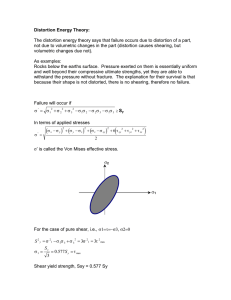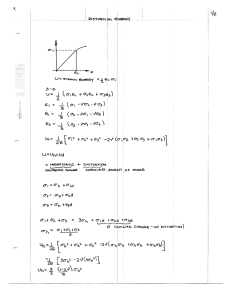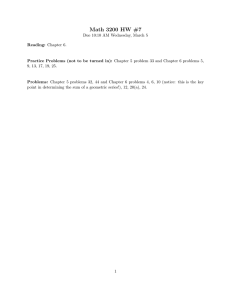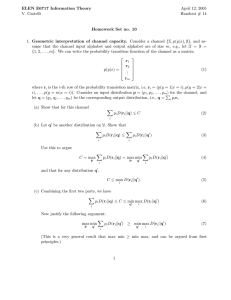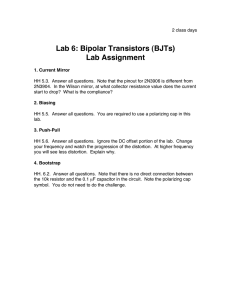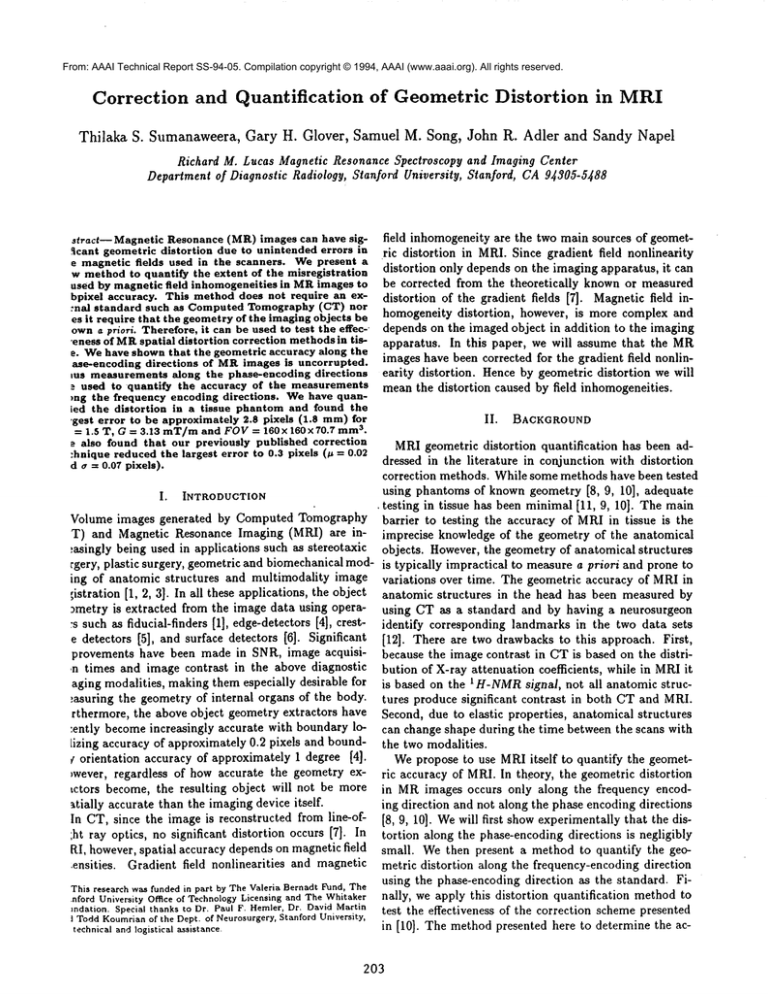
From: AAAI Technical Report SS-94-05. Compilation copyright © 1994, AAAI (www.aaai.org). All rights reserved.
Correction
Thilaka
and Quantification
S. Sumanaweera,
Gary H. Glover,
of Geometric Distortion
Samuel M. Song, John R. Adler
in MRI
and Sandy Napel
Richard M. Lucas Magnetic Resonance Spectroscopy and Imaging Center
Department of Diagnostic Radiology, Stanford University, Stanford, CA 94305-5488
stract--Magnetic Resonance(MR)images can have sig.qcant geometric distortion due to unintendederrors in
e magnetic fields used in the scanners. Wepresent a
w methodto quantify the extent of the misregistration
used by magnetic field inhomogeneities in MRimages to
bpixel accuracy. This methoddoes not require an ex:nal standard such as ComputedTomography(CT) nor
es it require that the geometryof the imagingobjects be
own~ priori. Therefore,it can be used to test the etfec¯eness of MRspatial distortion correction methodsin tise. Wehave shownthat the geometric accuracy along the
ase-encoding directions of MRimages is uncorrupted.
ms measurementsalong the phase-encoding directions
.~ used to quantify the accuracy of the measurements
mg the frequency encoding directions. Wehave quanled the distortion in a tissue phantomand found the
’gest error to be approximately2.8 pixels (1.8 mm)for
= 1.5 T, G= 3.13 mT/m
and FOV3.
= 160 x 160 x 70.7 mm
also found that our previously published correction
¯ hniquereducedthe largest error to 0.3 pixels (~ = 0.02
d a = 0.07 pixels).
field inhomogeneity are the two main sources of geometric distortion in MRI. Since gradient field nonlinearity
distortion only depends on the imaging apparatus, it can
be corrected from the theoretically
knownor measured
distortion of the gradient fields [7]. Magnetic field inhomogeneity distortion,
however, is more complex and
depends on the imaged object in addition to the imaging
apparatus.
In thispaper,we willassumethatthe MR
images
havebeencorrected
forthegradient
fieldnonlinearitydistortion.
Henceby geometric
distortion
we will
meanthedistortion
causedby fieldinhomogeneities.
II.
BACKGROUND
MRIgeometric distortion quantification has been addressed in the literature in conjunction with distortion
correction methods. While some methods have been tested
using phantoms of known geometry [8, 9, 10], adequate
I.
INTRODUCTION
¯ testing in tissue has been minimal [11, 9, 10]. The main
Volume images generated by Computed Tomography barrier to testing the accuracy of MRIin tissue is the
T) and Magnetic Resonance Imaging (MRI) are
imprecise knowledge of the geometry of the anatomical
:asingly being used in applications such as stereotaxic
objects. However, the geometry of anatomical structures
rgery, plastic surgery, geometric and biomechanical mod- is typically impractical to measure a priori and prone to
ing of anatomic structures and multimodality image variations over time. The geometric accuracy of MRIin
~istration [1, 2, 3]. In all these applications, the object anatomic structures in the head has been measured by
>metry is extracted from the image data using opera- using CT as a standard and by having a neurosurgeon
:s such as fiducial-finders [1], edge-detectors [4], crest- identify corresponding landmarks in the two data sets
e detectors [5], and surface detectors [6]. Significant
[12]. There are two drawbacks to this approach. First,
provements have been made in SNR, image acquisibecause the image contrast in CT is based on the distri.n times and image contrast in the above diagnostic
bution of X-ray attenuation coefficients, while in MRIit
aging modalities, makingthem especially desirable for is based on the t H-NMRsignal, not all anatomic struc~asuring the geometry of internal organs of the body. tures produce significant contrast in both CTand MRI.
rthermore, the above object geometry extractors have Second, due to elastic properties, anatomical structures
:ently becomeincreasingly accurate with boundary lo- can change shape during the time between the scans with
[izing accuracy of approximately 0.2 pixels and bound- the two modalities.
orientation accuracy of approximately 1 degree [4].
Wepropose to use MRIitself to quantify the geomet,wever, regardless of how accurate the geometry ex- ric accuracy of MRI. In theory, the geometric distortion
tctors become, the resulting object will not be more in MRimages occurs only along the frequency encod~tially accurate than the imagingdevice itself.
ing direction and not along the phase encoding directions
In CT, since the image is reconstructed from line-of[8, 9, 10]. Wewill first showexperimentally that the dis;ht ray optics, no significant distortion occurs [7]. In tortion along the phase-encoding directions is negligibly
RI, however, spatial accuracy depends on magnetic field
small. Wethen present a method to quantify the geo:ensities. Gradient field nonlinearities and magnetic metric distortion along the frequency-encoding direction
using the phase-encoding direction as the standard. FiThis
research
wasfunded
inpartbyTheValeria
Bernadt
Fund,
The
nally, we apply this distortion quantification method to
.nford
University
Office
ofTechnology
Licensing
andTheWhitaker
mdation.
Special
thanks
toDr.PaulF.Hemler,
Dr.David
Martintest the effectiveness of the correction scheme presented
I Todd
Koumrian
oftheDept.
ofNeurosurgery,
Stanford
University,
in [10]. The method presented here to determine the actechnicalandlogisticalassistance.
203
magnetic field fluctuation. This holds true for any pair
of corresponding artificial or natural point-like landmarks
identifiable in the two image sets, X and Z.
To demonstrate that the x-coordinate
of Pz and
z-coordinate of Px were accurate, we first used the artificial
landmarks of images from X and Z to show that
the geometric distortion along the phase-encoding direction was negligibly small. The magnetic susceptibility
of tissue perturbed the B0-field in tissue. On the other
hand, since the magnetic susceptibility of air was unithe uniform B0
Fig.I. Left:The tissuephantomcontaineda tissuesamplecomprising form, we assumed that it did not distort
a gamehen placedex tdt, o in a Plexiglassbox.Coppersulfate-filled field in air. Therefore, we expected the portions of the
capillarytubes wereinsertedinto the tissue.Partsof the tubeswere
fiducials in tissue to be shifted along the frequency eninsidetissuewhile the remainingportionswere leftin air. Right:A
slice throughthe tissue phantom. The bright spots are produced by
coding direction while remaining straight in air. To show
the coppersulfatecapillary
tubes.
this, straight lines were fit to the fiducial points in air.
It was found that the fiducial points in tissue did not
curacyof MRIin tissuedoesnotrequire
an alternativeshift significantly from this straight line along the phasestandard,
suchas CT,nordoesit require
thatthegeom- encoding direction. In order to remove any global bias
etryof theimaged
objects
be knowna pr/0ri.
It requiresin the z- and z-coordinates of all the fiducial points in
onlythatcorresponding
pointscanbe identified
in two the two scans X and Z, the fiducial points in air in the
two sets were aligned. This was done by estimating the
MRIimagesof thesameobjectslice.
global disparity of the z- and z-coordinates of the fiducial
Ill. METHOD
points in air and removing this bias from the data.
The copper sulfate-filled
tubes provide high-contrast
A tissue-phantom
shownin theleftsideof Figure1 point-like landmarks in tissue which can then be used
was used to demonstrateour method.Two 3DFT MR to quantify the geometric distortion in MRI. For obvious
experiments
were performed
with 16 cm FOV,0.625mm reasons it is not practical to use copper sulfate-filled tubes
resolution
on thezx-plane
and0.7 mm resolution
along in real patients. Thus to demonstrate practicality of our
the~-direction.
In thefirstexperiment,
X, theread-outmethod in patients, natural landmarks such as curvature
direction was along z while in the second, Z, it was along discontinuities of edges in the images were used. Several
z. For each slice, a B0-map was also calculated using pairs of points of curvature discontinuities of the edges in
the method outlined in [10] and the phase-unwrapping the images from the sets X and Z were visually identified.
technique described in [13]. The B0-map was required
for the geometric distortion correction scheme. The right
IV. RESULTS
side of Figure 1 shows a zz-slice through the volume.
Wefirst give qualitative results. Graph A of the right
To test our method, two types of landmarks were used:
artificial and natural. Artificial landmarks were gener- side of Figure 2 shows an orthographic projection of the
ated by the capillary tubes while natural landmarks were fiducial points of four tubes from the set X into the xygenerated by the boundaries of anatomical structures ex- plane. Also shown for each fiducial marker is a straight
tracted by the Wang-Binfordedge-detector [4]. The bright line fit in the least-squares sense to the fiducial points in
air and extrapolated into the tissue. Notice the shifts that
spots produced by copper sulfate capillary tubes typically
spanned 5 x 5 pixel neighborhoods. Wefitted a 2D Gaus- have taken place along the frequency-encoding direction,
sian profile to the 5 x 5 neighborhoods to estimate the x. Significant shifts have taken place where the fiducials
locations of the fiducials to subpixel accuracy [14]. The are inside the tissue while lines remain straight when the
fiducials are in air. Next, the correction methoddescribed
left side of Figure 2 showsthe locations of the artificial
fiducials on a particular slice. Consider the fiducial in- in [10] was applied to the set X. Graph B ofthe right side
of Figure 2 showsthe projection of the new fiducial points
side the highlighted square (fiducial (3)). Let the
location of the fiducial be P. Then, due to the magnetic on the zy-plane. Compared with graph A, the fiducials
field inhomogeneities induced by the object, P shifted to now lie on straight lines as expected. Graph C of the
Px in the set X (read-out along z) and to Pz in the right side of Figure 2 shows the orthographic projection
set Z (read-out along z). Since geometric distortion was of the fiducial points into the zy-plane showing the minnot expected along the phase-encoding directions, the z- imal distortion along the phase-encoding direction. By
coordinate of Px and the z-coordinate of Pz could he comparing graphs B and C, the locations of the fiducials
along the frequency-encoding direction after correction
regarded as accurate. Moreover, the error, dr, was estimated by subtracting the z-coordinate of Px from the lie on lines nearly as straight as the lines generated by
z-coordinate of Pz, and the error, dz, by subtracting the the locations of the fiducials along the phase-encoding
z-coordinate of Pz from the z-coordinate of Px. More- direction.
In order to quantify the accuracy of the MRIimages
over, dz = dz as these shifts are proportional to the local
204
A
I
pixels
i
"
(2)J~
After correction
I" "I
P~’e£
T
-~
(4)
(8)+
’t
97pixels
pixeis
~ lOODixclsf 62.Smm}
X
v~
:
~.
79 pixels
~
~. 2. Left:Fiducialsdetectedfrom the two experiments:
dots correspond
to ~ read-outdirection(setX) whilecrossescorrespond
to z rea~i-out
"ection(set Z). Noticethe spatially-varying
disparitiesbetweenthe two experiments.
Right:Az Orthographic
projection
of the fiducialsfrom
: X into the xy-planeshowingthe deformations
alongthe frequency-encoding
direction,
x. x- and z-axesof the graphsare exaggerated
compared
y-axisto show the geometricdistortion
of the flducials.Pixelsizealongx-and z-axeswas 0.625mm whilethatalong the y-axiswas 0.7 ram.
raightlineswerefit to the flducial
pointsin air.Noticethe significant
distortion
of the fiducials
in tissuefromthesestraight
lines.B: The same
:er applyingthe distortion
correctionmethod.C: Orthographic
projectionof the fiducialsfromset A" intothe zy-planeshowingthe negligible
formationsalong the ph~e-encoding
direction,z.
o
sQI
.................
....
...........
..............
........
.....
-o_~l-.....i ........~ i .. i ........
-l| ,
,
;
,
,
!
~
i
~.’xt,/.
"’0.~l,’.~
"’" ’
0.5
0
:’".
’"’i
......
’""""’<’..-."i
..........
-0.5
.,,.
.-.
~
. ~), ~.~
-I
)
.’ ~
-I.5
¢
~’.))
~. a’O
¯
$
i..
~ ¢~.I
-2
-2.5
-3
-3%2’oio
Slice
Number
(A)
(B)
;. 3. (A): Top: Distortion along the phase-encoding direction in pixel units (mean: # = 0.0, standard deviation: ~ = 0.03, range = [--0.08, 0.12]);
ttom: Distortion along the frequency-encoding direction before correction (solid line, range = [-2.84,-0.36])
and after correction
(asterisks,
-- 0.02, c~ = 0.07, range = [-0.21,0.27]).
(B): The edges of an MRimage of the tissue phantom and a set of landmarks identified.
foreandaftercorrection
andthereby
to findtheef- culating
thedeviation
ofthefiducial
points
intissue
from
:tiveness
of thecorrection
scheme,
thephase-encoding
thefitlinesalongthephaseencoding
direction.
Thetop
3A showserrors
foronesuchfiducial.
The
¯ ection
wasusedasthestandard.
First,
thedistortiongraphin figure
was0.00pixelswhilethestandard
devi)ngthephaseencoding
direction
wasquantified
by cal- meandeviation
205
Point
A
B
C
D
E
F
.y
Before
123.61
134.41
126.97
159.84
118.60
168.76
Z
~rroF
120.60
134.99
125.99
160.75
116.77
169.69
3.01
-0.58
0.98
-0.91
1.84
-0.93
X
After
120.68
134.77
125.99
160.41
116.72
169.28
V.
Residual
Error
-0.08
0.23
0.001
0.33
0.05
0.41
Table 1. The distortion along the read-out direction (z) measuredusing a set of natural landmarks. All number5are in pixel-units. ’ The
second and third columns show the x-coordinates of the landmarks in
the images from set X and Z respectively. The fourth columnshows
the disparity between
the z-coordinatesof the points in the two images.
Shownin the fifth columnare the ~-coordinates of the landmarksafter
applying the correction scheme.Finally, columnsix showsthe residual
error. Theworst case error before correction was3 pixels (1.8"/5 ram)
while the worst caseerror after correction was0.4 pixels (0.25 ram).
CONCLUSION
A new method to quantify the geometric accuracy of
MRIin tissue has been presented, where the phase-encoding
directions of MRimages were used as standards against
which the geometric accuracy of MRimages were tested.
This allows verification to be done in tissue of any anatomic
structure visible in MRIand eliminates the need to use
a second modality such as CT, or phantoms of known
geometry. Using this method, we showed that the accuracy of our correction methodpresented in [10] is less
than a pixel and also enables the accuracy of correction
schemes to be tested as long as points can be defined
in MRscans. We have also demonstrated how natural
landmarks of anatomical structures can be used for this
purpose, enabling in viva testing.
REFERENCES
ation was 0.03 pixels. The maximumand minimumdeviations were 0.12 and -0.08. These statistics correspond
to 101 slices covering a range of 70.7 mm.Other fiducials
located in the 16 x 16 cm2 FOVhad similar errors. Hence
it maybe concluded that there is no significant geometric
distortion along the phase-encoding direction.
Knowingthat the errors along the phase-encoding direction are small, the coordinates of the phase-encoding
direction of the images in Z were used to quantify the
geometric distortion along the frequency-encoding direction of the images in X. The graphs at the bottom of
Figure 3A show the errors along the frequency-encoding
direction of the fiducial in set X. The solid line corresponds to the geometric distortion before correction.
The range of deviations of the fiducials from the standard was [-2.84 to -0.36] pixels. The asterisks correspond
to the errors after applying the correction method. After
correction, the range was [-0.21, 0.27] pixels with mean
0.02 pixels and a standard deviation of 0.07 pixels. The
relatively larger variations of the residual errors between
slices 30 and 40 and again between slices 70 and 80 may
have been caused by the errors in the B0-mapcaused by
to fat/water superposition [10].
The point correspondence in the two experiments, X
and Z, was established by using the high-contrast fiducials in the images created by the copper sulfate-filled
capillary tubes. In real patient images natural landmarks
can be used instead, as follows. Figure 3B shows a set of
edges detected from an image of set X. These edges were
detected using the Wang-Binford edge detector, which
has been shownto localize object boundaries with about
0.2 pixel accuracy when the image intensity changes by
a factor larger than about 5 across the boundary in a
step fashion [4]. Points h through V correspond to a set
of landmarks identified manually using discernible curvature discontinuities of the edges. The same landmark
points were identified in the corresponding image of set
Z. Table I shows the quantification results.
206
[1] P. F. Hemler, T. Koumrian, J. R. Adler, and B. L. Guthrie,
"A Three Dimensional Guidance System for Frarneless Stereotactic Neurosurgery,"
in Fifth Annual IEEE ConJerence on
Computer-Based
Medical Systems,
(Durham, NC), IEEE,
July 1992.
Display and Anal[2] R. A. Robb and C. Baxillot, "Interactive
ysis of 2D Medical Images," IEEE Transactions
on Medical
Imaging, vol. 3, pp. 217-226, September 1988.
[3] C. A. Pellzzari,
G. Chen, D. Spelbring, R. Weichselbaum, and
C. Chen, "Accurate, Three-dimensional Registration
of CT,
PET, and/or MR Images of the Brain," Journal of Computer
Assisted Tomography, vol. 13, pp. 20-26, 1989.
[4] S. J. Wang and T. O. Binford, "Local Step Edge Estimation:
a’New Algorithm, Statistical
Model and Performance Evaluation," in Proceedings of the Image Understanding Workshop,
DARPA, 1993.
[5] J. Thirion, ’*The 3D Marching Lines Algorithm and its Application
to Crest Lines Extraction,"
Rapports de Recherche
1672, INRIA, Domanine de Voluceau Rocquencourt;B.P.
105,
78153 Le Chesnay Cedex, France, May 1992. Programme 4,
Robotique, Image et Vision.
[6] P.T. Sander and S. W. Zucker, "Traclng Surfaces or Surfacing
Traces," in Proc. 1st Int. Conf. Computer Vision, pp. 231240, June 1987.
[7] T. S. Sumanaweera, Segmentation and Distortion Correction
in Medical Imaging. PhD thesis, Stanford University,
Dept.
of Electrical Engineering, Stanford, CA94305, 1992.
[8] K. M. Lfideke, P. RSschmann, and R. Tischler, "Susceptibility
Artifacts
in NMRImaging," Magnetic Resonance Imaging,
vol. 3, pp. 329--343, 1985.
"Geometric Image Transfor[9] H. Chang and J. Fitzpatrick,
mation to Compensate for MRI Distortions.;"
SPIE Medical
Imaging IV: Image Processing, vol. 1233, pp. 116-127. 1990.
[10] T. S. Sumanaweera, G. H. Glarer, T. O. Binford, and J. R.
Adler, "MR Susceptibility
Misregistration
Correction," IEEE
Transactions on Medical Imaging, vol. 12, June 1993.
[11] Z.H. Cho, D. J. Kim, and Y. K. Kim, "The Total Inhomogeneity Correction Including Chemical Shift and Susceptibility
by
View Angle Tilting," Medical Physics, vol. 15, Jan/Feb 1988.
[12] L. Schad, S. Lott, F. Schmitt, V. Sturm, and J. W. Lorenz,
"Correction of Spatial Distortion in MRImaging: A Prerequisite for Accurate Stereotaxy," Journal of Computer Assisted
Tomography, vol. 11, no. 3, pp. 499-505, 1987.
[13] S. M. Song, G. O. Pike, N. J. Pelc, and G. H. Glarer, "Dynamic Range Extension of Phase Contrast Velocity Measurements," in Proceedings of the Twelfth Annual Scientific Meeting, August 1~-20, vol. 1, p. 507, Society of Megnetic Resonance in Medicine, 1993.
[14] T. Sumanaweera, G. Glarer, S. Song, J. Adler, and S. Napel,
"Quantifying MRI Geometric Distortion in Tissue." Magnetic
Resonance in Medicine (in press), 1993.

